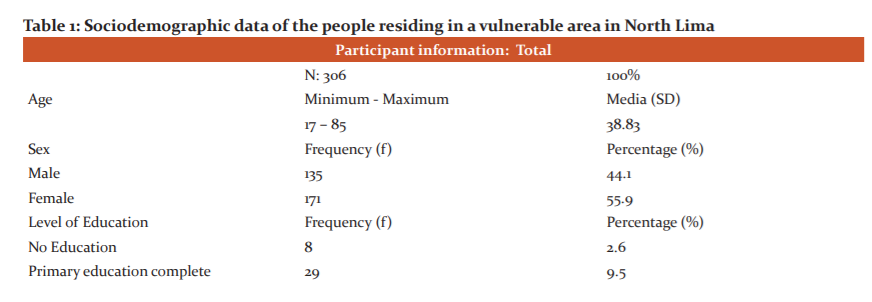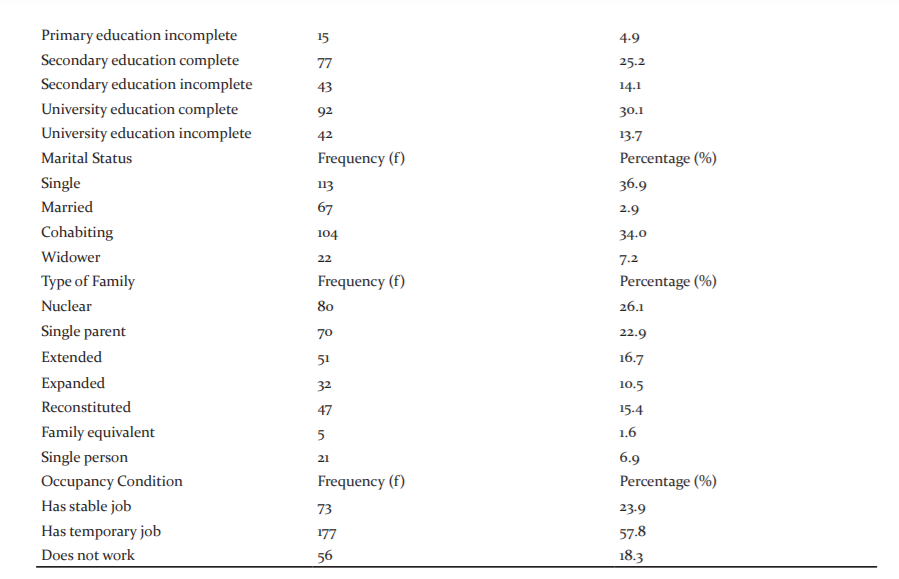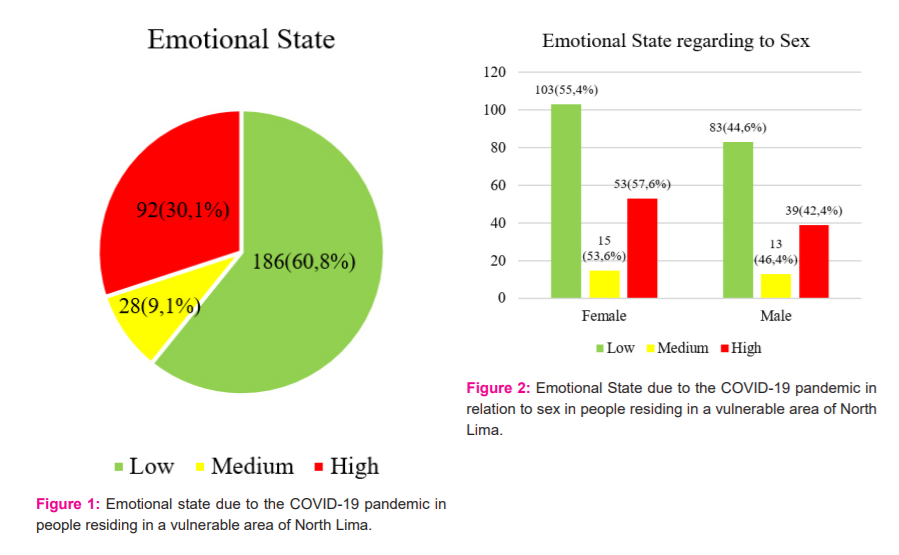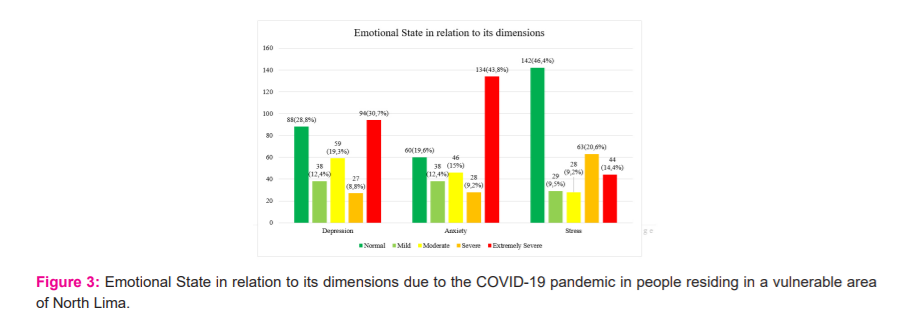IJCRR - 13(14), July, 2021
Pages: 15-20
Date of Publication: 20-Jul-2021
Print Article
Download XML Download PDF
Emotional State Due to the Covid \? 19 Pandemic in People Residing in a Vulnerable Area in North Lima
Author: Rosa PS, Hernan MS, Eduardo MS, Anika RA
Category: Healthcare
Abstract:Background: The COVID-19 pandemic has generated a negative impact on the emotional state of people and makes them more susceptible to presenting different symptoms that compromise their mental health. Objective: The objective is to determine the emotional state due to the COVID-19 pandemic in people who reside in a vulnerable area in North Lima. It is a quantitative, descriptive, non-experimental cross-sectional study, with a total population of 306 participants from the Carabayllo district who responded to a questionnaire on sociodemographic data and the depression, anxiety, and stress scale (DASS-21). Results: In the results, we observe the emotional state, where 186 (60.8%) of the participants present a low emotional state, 92 (30.1%) have a high emotional state and 28 (9.1%) have a medium emotional state. Conclusions: It is concluded, virtual medical care should be carried out for the mental health care of vulnerable people.
Keywords: Depression, Anxiety, Stress, Pandemic, Coronavirus
Full Text:
Introduction
From a global perspective, the coronavirus pandemic (COVID - 19) has triggered unprecedented alterations,1 where a latent threat has been found in the population in their emotional state that generates a negative impact that compromises both their health and how to prevent it.2
The health crisis that exists worldwide due to the COVID-19 pandemic has triggered multiple factors that compromise the emotional state of the general population,3 where high rates of depressive symptoms, anxiety and stress pictures are evident due to the confinement and self-quarantine of the population.4,5
Although, not only have these factors been seen in the population,6 but they are also prone to experiencing loneliness, anguish, sadness and worry generated by quarantine and isolation in their homes since sometimes some people tend to live alone in their homes and experience these factors mainly.7
All these factors have not only been caused by the COVID-19 outbreak in the population, but are also due to the preventive measures that were taken by the government,8, COVID - 19 will play a fundamental role in the implications that not only affect people's physical well-being, but also their psychological well-being.9
Therefore, the impact of the COVID-19 pandemic is one of the causes that generate a very high emotional burden, where the person does not tolerate certain prevention measures, isolation and quarantine makes their mental health more vulnerable.10
In a study in Spain, with 3480 participants aged 18 years old and over, its results showed that in females 18.7% presented depression, 21.6% anxiety and 15.8% present post-traumatic stress, concluding the female sex with health problems, presenting symptoms related to COVID - 19 and having a close relative infected, make her more vulnerable to presenting these factors compromising her mental health.11
In a study conducted in Australia,12 with 3770 study participants, they stated that 21.6% of the participants had moderate to highly severe depression, 28.6% moderate to highly severe anxiety and 28% moderate to highly severe stress, although between 22% and 29% of the participants of both sexes presented symptoms of depression, anxiety and stress, although the majority were seen more in sex feminine than masculine.
In a study carried out in Turkey, with 2076 participants who are health workers, their results stated that 86.9% of health workers were afraid of infecting their relatives with COVID - 19 and due to this, they manifested a high index of depression, anxiety and stress, they infect the members in their homes.13
Therefore, the objective of the research is to determine the emotional state due to the COVID-19 pandemic in people who reside in a vulnerable area in North Lima.
Therefore, its hypothesis in the research work is that the emotional state is presented negatively due to the isolation and quarantine of the population caused by the COVID-19 pandemic.
Methodology
Type of Research
In the present research work, due to its properties and the way of collecting data according to the present variables, it is a quantitative approach, with a descriptive, non-experimental and cross-sectional methodological design14.
Population
The study covered 306 study participants from the ages of 17 to 85 who live in a Human Settlement in the Carabayllo district. Also, the Sociodemographic data o the population is shown in Table I.
Inclusion criteria
-
People ranging in age from 17 to 85 years old.
-
People who are voluntarily present in the research work.
-
People residing in the Carabayllo district.
-
People who signed the consent informed ACTAN°050-2020-CE/UMA UNIVERSIDAD MARIA AUXILIADORA
Technique and instrument
The technique for the study was carried out using the DASS-21 questionnaire or data collection instrument, which aims to measure the emotional state of the COVID-19 pandemic in people residing in a vulnerable area of ??North Lima.
The depression, anxiety, and stress scale (DASS-21), each of the three DASS scales contain 14 items, divided into subscales of 2 to 5 items with similar content. The depression scale assesses dysphoria, hopelessness, devaluation of life, self-loathing, lack of interest or participation, anhedonia, and inertia. The anxiety scale assesses autonomic arousal, skeletal muscle effects, situational anxiety, and the subjective experience of anxious affect. The stress scale is sensitive to levels of non-specific chronic arousal. It evaluates the difficulty to relax, the nervous excitement and the discomfort, agitation, or irritation, over-reactivity and impatience. It consists of 4 answer alternatives, 0 "not at all", 1 "sometimes", 2 "many of the time" and 3 "most of the time" to rate the degree to which they have experienced each state during the past week. To obtain the final score of the DASS-21, the total score obtained must be multiplied by two (data x2).14,15
The validity of the instrument to measure emotional state was determined based on the exploratory factor analysis technique. The Kaiser-Mayer-Olkin sample adequacy measure obtained a coefficient of 0.962 (KMO> 0.5), while the Bartlett sphericity test obtained significant results (X2 approx. = 7050.468; gl = 210; p = 0.000).
The reliability of the instrument was determined with the Cronbach's Alpha statistical test, in which a coefficient of 0.977 (α> 0.8) was obtained for the items (i = 21).
In this research work, the depression, anxiety, and stress scale (DASS-21) will be used as a data collection instrument. The data collection processing was through the questionnaire in people residing in a vulnerable area of ??North Lima, in which the matrix for the database was carried out in the SPSS Statistics Base 26.0 program, in which the data analysis and processing to make tables and figures to later be described and interpreted in results and discussions, respectively.
Place and application of the instrument
The questionnaire was carried out to measure the emotional state due to the COVID-19 pandemic in people residing in a vulnerable area of ??North Lima, in which it was carried out in the district of Carabayllo, in the Las Malvinas de Carabayllo Human Settlement
Coordination was made first with the directive members for the permits to carry out the research, then the corresponding permission for each head of household explaining about the study, also knowing what is going to be carried out.
The questionnaire only took approximately 15 minutes to fill out, and at the time of collecting the surveys, we concluded that people supported us in the study, generating an atmosphere of trust and satisfaction in the study.
Results
In Figure 1 and Table 1, we observe the emotional state, where 186 (60.8%) of the participants have a low emotional state, 92 (30.1%) have a high emotional state and 28 (9.1%) have a medium emotional state.
In Figure 2, we can see that the female sex presents a low emotional state 103 (55.4%) than the male sex 83 (44.6%), at the medium level the female sex 15 (53.6%) and the male sex 13 (46.4%) and a high level 53 (57.6%) female and 39 (42.4%) male.
In Figure 3, the emotional state is observed about its dimensions, where we can see that in the depression dimension, 94 (30.7%) of the population have extremely severe depression, followed by 88 (28.8%) with normal depression, 59 (19.3%) with moderate depression, 38 (12.4%) with mild depression and 27 (8.8%) with severe depression, in terms of their anxiety dimension, we observe that 134 (43. 8%) of the population presents extremely severe anxiety, 60 (19.6%) with normal depression, 46 (15%) with moderate depression, 38 (12.4%) with mild depression and 28 (9.2%) with severe depression and in its stress dimension, we observed that 142 (46.4%) of the population presented normal stress, 64 (20.6%) severe stress, 44 (14.4%) extremely severe stress, 28 (9.2%) moderate stress and 29 (9.5%) mild stress.
In Table 2, we observe the relationship between the emotional state and the level of education in people residing in a vulnerable area of ??North Lima, which was determined with Pearson's chi-square test (X2). The level of significance of the test obtained a value of 0.73 (p> 0.05) (X2 = 40.627; d.f = 12). Therefore, an association hypothesis is not rejected, for which there is statistical data that verify the relationship between the emotional state and the level of education. In which, we can interpret that people with university education complete 68 (73.9%) have a low emotional state, followed by secondary education complete 45 (58.4%), university education incomplete 28 (66.7%), secondary education incomplete 24 (55.8%) and people with primary education complete have a high emotional state 14 (48.3%).
Discussions
The research work has emphasized the emotional state from a focus on mental health in the general population, which seeks to carry out preventive strategies that allow the population to maintain or improve at a psycho-emotional level that allows them to cope with the situation in which are undergoing quarantine and isolation because of the COVID-19 pandemic.
The results reflected that the emotional state of the population is low, this is because many of the population have not been able to cope with the COVID-19 pandemic since last year, where the risk of being infected has impacted at the level of mind them, where factors such as depression, anxiety and stress that are the main ones in affecting their emotional state, since being in quarantine and isolation make people unable to face this situation in the most appropriate way. They argue that depression, anxiety and stress are factors that compromise people's mental health, where it makes them vulnerable to any situation that they cannot confront, and due to this, they are prone to have negative ideas in themselves and can hurt themselves by not knowing how to deal with it7.
Regarding sex, it is observed that the female sex presents a lower emotional state than in the male sex, this is because the psycho-emotional burden in the female sex is highly compromised not only because the COVID-19 pandemic affects their daily routines and puts their well-being at risk, but also affects due to factors such as infected or deceased family members, the alarming increase in positive cases, makes the symptoms of anxiety and stress mainly become more noticeable. They argue that women are more susceptible to their emotional state is altered, where factors such as apathy, sadness, despair, pessimism and low self-esteem, are indications that the person presents high depressive symptoms since when more depression is serious, anxiety and stress begin to rise, complicating their physical and mental well-being11.
Regarding its dimensions, it can be observed that depression and anxiety are highly compromised, this is because as a result of the health crisis caused by the COVID-19 pandemic, since, during confinement at home, people have problems such as Insomnia, changes in appetite and physical activity, feelings of frustration, guilt, loneliness and helplessness and lack of courage, all of which have caused anxious depressive symptoms in the population and this can be considered aggravated causing obsessive and hypochondriacal behaviours. They argue that quarantine and isolation have generated difficulties in people, factors such as inactivity, sedentary lifestyle, inadequate food intake, insomnia, fatigue and worry, since all this manifests itself because depressive symptoms are present and because of this these factors are becoming more noticeable12.
Conclusions
It is concluded that virtual medical care should be carried out for the mental health care of vulnerable people.
It is concluded to carry out strategies to promote mental health, such as relaxation activity, healthy diet, adequate water intake, daily breaks and maintaining sociable contacts, since they are important to reduce anxiety, depression, and stress in people.
It is concluded that it is necessary to intervene in public and mental health to improve the perceptions of the person of risk to COVID-19, the concern for loneliness and improve the state of mind so that they improve the person in a positive way
The limitation in the research work is the few studies that have been carried out in our country since in these times mental health is what is being prioritized more because over time it can generate conflicts and consequences in people due to the consequences by COVID - 19.
This study will be beneficial because there have been no studies where the research was raised and the instrument details important points to know how the population is at a mental level due to COVID - 19.
Conflict of Interest
The authors declare no conflict of interest.
Funding Source
This research work does not have Funding Sources
Acknowledgement
The authors acknowledge the immense help received from the scholars whose articles are cited and included in references of this manuscript. The authors are also grateful to authors/editors/publishers of all those articles, journals, and books from where the literature for this article has been reviewed and discussed.
Author’s Contributions
Rosa PS: Conceived and designed the analysis, wrote the paper and translation.
Hernan MS: Collected the data, Performed the analysis.
Eduardo MS: Contact the people for the survey-taking.
Anika RA: Contributed data and analysis tools.





References:
1. García L, Romero V, López P, Padilla S, Rodriguez R. Mental Health in Elderly Spanish People in Times of COVID-19 Outbreak. Am J Geriatr Psych. 2020;28(10):1040–5.
2. Jia R, Ayling K, Chalder T, Massey A, Broadbent E, Coupland C, et al. Mental health in the UK during the COVID-19 pandemic: cross-sectional analyses from a community cohort study. Bri Med J . 2020;10(9):40620.
3. Zheng R, Zhou Y, Qiu M, Yan Y, Yue J, Yu L, et al. Prevalence and associated factors of depression, anxiety, and stress among Hubei pediatric nurses during COVID-19 pandemic. Compr Psychiatry. 2021;104:152217.
4. Jacob L, Smith L, Koyanagi A, Oh H, Tanislav C, Shin J, et al. Impact of the coronavirus 2019 (COVID-19) pandemic on anxiety diagnosis in general practices in Germany. J Psychiatr Res. 2020;2019(November).
5. Koksal E, Dost B, Terzi Ö, Ustun Y, Özdin S, Bilgin S. Evaluation of Depression and Anxiety Levels and Related Factors Among Operating Theater Workers During the Novel Coronavirus (COVID-19) Pandemic. J Perianesthesia Nurs. 2020;35(5):472–477.
6. Craig A, Hughes B, Swamy G. Coronavirus disease 2019 vaccines in pregnancy. Am J Obstet Gynecol 2021;3(2):100295.
7. Ren X, Huang W, Pan H, Huang T, Wang X, Ma Y. Mental Health During the Covid-19 Outbreak in China: a Meta-Analysis. Psychiatr Q. 2020;91(4):1033–1045.
8. Lahav Y. Psychological distress related to COVID-19 – The contribution of continuous traumatic stress. J Affect Disord. 2020;277:129–137.
9. Hasan A, Sadia M, Hossain S, Hasan M. The impact of COVID-19 pandemic on mental health & wellbeing among home-quarantined Bangladeshi students: A cross-sectional pilot study. J Affect Disord. 2020;277:121–128.
10. Werner E, Aloisio C, Butler A, Antonio K, Kenny J, Mitchell A, et al. Addressing mental health inpatients and providers during the COVID-19 pandemic. Semin Perinatol. 2020;44:151279.
11. González C, Ausín B, Ángel M, Saiz J. Mental health consequences during the initial stage of the 2020 Coronavirus pandemic (COVID-19) in Spain. Brain Behav Immun. 2020;87:172–176.
12. Hammond N, Crowe L, Abbenbroek B, Elliott R, Tian D, Donaldson L, et al. Impact of the coronavirus disease 2019 pandemic on critical care healthcare workers’ depression, anxiety, and stress levels. Aust Crit Care. 2020;19(7):1–9.
13. Tengilimo?lu D, Zekio?lu A, Tosun N, I??k O, Tengilimo?lu O. Impacts of COVID-19 pandemic period on depression, anxiety and stress levels of the healthcare employees in Turkey. Leg Med. 2021;48:101811.
14. Hernández R, Fernández C, Baptista P. Metologia de la Investigación. 2017. p. 1–634.
15. Lovibond A. Depression Anxiety Stress Scale (DASS-21). J Psychiatr Res.1995;19(3): 67-71.
|






 This work is licensed under a Creative Commons Attribution-NonCommercial 4.0 International License
This work is licensed under a Creative Commons Attribution-NonCommercial 4.0 International License